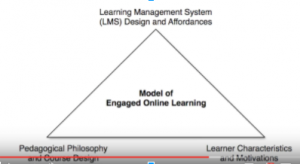Beginning the Process
- Expanding our thinking of the potential for a flipped classroom
- Most technologies simply aim to replicate the traditional classroom.¹ How can a virtual environment magnify the learning experience for students instead of replicate it in a new setting?³
- Integrated, or Backward, Course Design is a recommended pedagogy for developing learning goals, then teaching & learning activities. (Check out this article from the Chronicle of Higher Ed to learn more)
- Transitioning to a flipped classroom provides an opportunity to analyze your course content and identify how your learning objectives can be heightened through online educational platforms
- Re-defining our roles as teachers and educators²
- Develop knowledge in new learning theories and adapt to a quickly changing system of learning environments; Change our ways of thinking about student learning and engagement to keep up with new opportunities¹
- Recognize that learning management systems are one aspect of providing engaged online learning (see model below)¹ and provide training to help educators recognize the 3 aspects to develop engaged learning online
- Developing clear goals and needs
- Many times, educational tools have been selected out of proximity, low cost, or ease of implementation. This can lead to the selection and implementation of a program that does not work with current systems or does not fulfill needs of all stakeholders.
- Identify necessary infrastructure and data storage to support cloud-based learning²
- Select a lead person that oversees committees for evaluation, implementation, and follow-up assessment
Research & Exploration
- Take a bottom-up approach, rather than top-down.
- Identify stakeholders: Student utilization should be examined, as well as teachers. Typically these decisions are made my upper-level administrators. How can it become a group decision? By involving parents and students, issues regarding access and the digital divide can be included as part of the research process.
- Recognize that relying on anecdotal suggestions from colleagues is only one aspect of selecting an educational tool that meets the goals and needs of your situation
- Ask for narratives or contacts of people who have used the platform in similar aspects that you intend to use it for
- Understand it may be more than one platform or program to meet needs and testing out a few platforms.
- Examine various platforms to see how different goals and needs are met through various tools.
Narrowing & Selecting
- Utilize a chart with all stakeholders goals and needs to assess potential platforms
- Ask each group of stakeholders to practice and evaluate
- Communicate the shared vision
- Develop a holistic strategy of implementation
- Consider professional development and training
- Evaluation committee works to provide a comprehensive review
- Get buy-in from all stakeholders throughout the process
- Follow-up assessment committee aims to ensure continued utilization and evaluation of the educational tool

Citations
¹Rusch, A. [Adam Rusch]. (2017, June 10). Engaged Online Learning: The Future of Teaching [Video File]. Retrieved from https://www.youtube.com/watch?v=7CiwLTIQcr4.
²Britland, M. (2013). What is the future of technology in education? The Guardian. Retrieved from https://www.theguardian.com/teacher-network/teacher-blog/2013/jun/19/technology-future-education-cloud-social-learning.
³ Bush, T. (2012). Future Impact of Technology on Teaching and Learning. Microsoft UK Higher Education Blog. Retrieved from https://blogs.msdn.microsoft.com/ukhe/2012/03/09/future-impact-of-technology-on-teaching-and-learning/.



